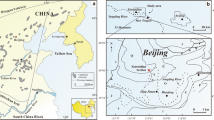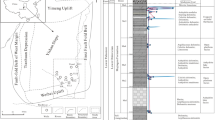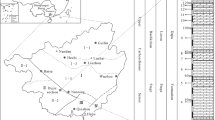Abstract
The diagenesis of ooids can be a valuable source of paleodepositional information. This study provides an example of ooids dolomitization in the Cambrian Zhangxia Formation, Xiaweidian, China. The ooids were extensively to completely replaced by euhedral dolomite crystals, but the interstitial material of the oolitic limestone was completely free of dolomitization. The selective dolomitization of the oolitic limestone is poorly understood. Stratigraphic, petrographic and X-ray diffraction data suggested that seepage reflux of the high-magnesium brine played a vital role in the early dolomite precipitation in the cortical laminae of the ooids before they were filled with interstitial materials. The sudden increased in the dolomite content of the oolitic limestone in carbonate containing gypsum provided key evidence for seepage-reflux dolomitization of the ooids. The higher porosity and permeability of the high-magnesium fluid in radial ooids demonstrates that the degree of dolomitization was higher than in the concentric ooids. The distribution of the dolomite was strongly influenced by the original cortical structure of the ooids. These data have significant implications for paleoenvironmental studies in this area.







Similar content being viewed by others
References
Adams JE, Rhodes ML (1960) Dolomitization by seepage refluxion. Am Assoc Pet Geol Bull 44:1912–1920
Alqattan MA, Budd DA (2017) Dolomite and dolomitization of the Permian Khuff-C reservoir in Ghawar field. Saudi ArabiaSea. Aapg Bull 101(10):1715–1745
Badiozamani K (1976) The dorag dolomitization model application to the middle Ordovician of Wisconsin. J Sediment Res 43:965–984
Barale L, Bertok C, Talabani NS, D’Atri A, Préat A (2016) Very hot, very shallow hydrothermal dolomitization: an example from the Maritime Alps (north-west Italy-south-east France). Sedimentology 63:2037–2065
Batchelor MT, Burne RV, Henry BI, Li F, Paul J (2018) A biofilm and organomineralisation model for the growth and limiting size of ooids. Sci Rep 8:1–9
Butler GP (1969) Modern evaporite deposition and geochemistry of coexisting brines, the Sabkha, Trucial Coast, Arabian Gulf. J Sediment Res 39:70–89
Cui YQ, Wang JG, Tian JZ, Zhao ZJ, Xiao Y, Wang PX, Tian R, Song CG, Xiao F (2018) Reservoir characteristics and main controlling factors of Cambrian–Ordovician dolomite in the north central part of North China Platform. Acta Petrol Sin 39:890–901 (in Chinese with English abstract)
Cuia RD, Riva A, Scifoni A, Moretti A, Spotl C, Caline B (2011) Dolomite characteristics and diagenetic model of the Calcari Grigi Group (Asiago Plateau, Southern Alps—Italy): an example of multiphase dolomitization. Sedimentology 58:1347–1369
Davies PJ, Martin K (1976) Radial aragonite ooids, Lizard Island, Great Barrier Reef, Queensland, Australia. Geology 4:120–122
Davies GR, Smith LB Jr (2006) Structurally controlled hydrothermal dolomite reservoir facies: an overview. Aapg Bull 90(11):1641–1690
Davies PJ, Bubela B, Ferguson J (1978) The formation of ooids. Sedimentology 25:703–730
Deelman JC (1978) Experimental ooids and grapestones: carbonate aggregates and their origin. J Sediment Res 48:503–512
Dravis JJ, Wanless HR (2018) Reflux dolomitization—a holocene example beneath a coastal salina, West Caicos Island, Turks and Caicos Islands. Mar Pet Geol 97:311–322
Duguid SMA, Kyser TK, James NP, Rankey EC (2010) Microbes and ooids. J Sediment Res 80:236–251
Feng ZZ, Chen J, Wu SH (1989) Lithofacies paleogeography of early Paleozoic of North China Platform. Acta Sedimentol Sin 7:16–55 (in Chinese with English abstract)
Folk RL, Lynch FL (2001) Organic matter, putative nannobacteria and the formation of ooids and hardgrounds. Sedimentology 48:215–229
Gao G, Land LS, Folk RL (1992) Meteoric modification of early dolomite and late dolomitization by basinal fluids, upper Arbuckle Group, Slick Hills, southwestern Oklahoma. Am Assoc Pet Geol Bull 76:1649–1664
Gregg JM (1985) Regional epigenetic dolomitization in the Bonneterre Dolomite (Cambrian), southeastern Missouri. Geology 13:503
Guo QH, Jin ZK, An YC, Zhu XE (2019) Study on sedimentary environment and patterns of the Cambrian Zhangxia formation at Xiaweidian, Beijing. Acta Sedimentol Sin 37:40–50 (in Chinese with English abstract)
Halley RB (1977) Ooid fabric and fracture in the Great Salt Lake and the geologic record. J Appl Phys 47:1099–1120
Heller PL, Komar PD, Pevear DR (1980) Transport processes in ooid genesis. J Sediment Pet 50:943–952
Hsü KJ, Siegenthaler C (1969) Preliminary experiments on hydrodynamic movement induced by evaporation and their bearing on the dolomite problem. Sedimentology 12:11–25
Jiang N, Fan LX, Liu H, Liu ZY, Mei B (2013) Characteristics of the reef flat facies reservior in the Puguang Gasfield and the origin of dolomitization. Nat Gas Geosci 24:923–930 (in Chinese with English abstract)
Jones B (2013) Microarchitecture of dolomite crystals as revealed by subtle variations in solubility: implications for dolomitization. Sediment Geol 288:66–80
Krumbein WE (2006) Biomicrospheres generate ooids in the laboratory. Geomicrobiol J 23(7):545–550
Kruse PD, Reitner JR (2014) Northern Australian microbial-metazoan reefs after the mid-Cambrian mass extinction. Mem Assoc Australas Palaeontol 45:31–53
Li F, Wu SQ, Liu K (2015) Identification of ooid primary mineralogy: a clue for understanding the variation in paleo-oceanic chemistry. Acta Sedimentol Sin 33(3):500–501 (in Chinese with English abstract)
Lindholm RC, Dean DA (1973) Ultra-thin thin sections in carbonate petrology: a valuable tool. J Sediment Res 43:295–297
Ma YS, Mei MX, Zhou RX, Yang W (2017) Forming patterns for the oolitic bank within the sequence-stratigraphic framework: an example from the Cambrian Series 3 at the Xiaweidian section in the Western Suburb of Beijing. Acta Petrol Sin 33:1021–1036 (in Chinese with English abstract)
Machel HG (2004) Concepts and models of dolomitization: a critical reappraisal. Geol Soc Lond Spec Publ 235:7–63
Maliva RG, Missimer TM, Guo WX (2018) Paleohydrological modeling of penesaline reflux dolomitization: Avon Park Formation (Middle Eocene), East Central Florida. Carbon Evaporites. https://doi.org/10.1007/s13146-018-0448-8
Mei MX (2011) Depositional trends and sequence-stratigraphic successions under the Cambrian second-order transgressive setting in the North China Platform: a case study of the Xiaweidian section in the western suburb of Beijing. Geol Chin 28:317–337 (in Chinese with English abstract)
Mei MX, Mei SL (1997) Cyclic sequences of composite sea level change developed in Zhangxia formation of Middle Cambrian in North China. Acta Sedimentol Sin 15:7–12 (in Chinese with English abstract)
Min R, Jones B (2018) Genesis of island dolostones. Sedimentology. https://doi.org/10.1111/sed.12455
Müller DW, Mckenzie JA, Mueller PA (1990) Abu Dhabi sabkha, Persian Gulf, revisited: application of strontium isotopes to test an early dolomitization model. Geology 18:618–621
Pacton M, Ariztegui D, Wacey D, Kilburn MR, Rollion-Bard C, Farah R, Vasconcelos C (2012) Going nano: a new step toward understanding the processes governing freshwater ooid formation. Geology 40:547–550
Plee K, Ariztegui D, Martin R, Davaud E (2010) Unravelling the microbial role in ooid formation—results of an in situ experiment in modern freshwater Lake Geneva in Switzerland. Geobiology 6:341–350
Qiang ZT, Zeng DM, Wang XZ, Wu SJ (2012) Isotopic geochemical characteristics of oolitic bank dolostones in the Lower Triassic Feixianguan Formation in northeastern Sichuan Province. J Palaeogeogr 14:13–20 (in Chinese with English abstract)
Roberts JA, Kenward PA, Fowle DA, Goldstein RH, Gonzalez LA, Moore D (2013) Surface chemistry allows for abiotic precipitation of dolomite at low temperature. Proc Natl Acad Sci USA 110:14540–14545
Siahi M, Hofmann A, Master S, Mueller CW, Gerdes A (2017) Carbonate ooids of the Mesoarchaean Pongola Supergroup, South Africa. Geobiology 15:750–766
Souza RSD, Ros LFD, Morad S (1995) Dolomite diagenesis and porosity preservation in lithic reservoirs: Carmopolis member, Sergipe-Alagoas Basin, northeastern Brazil. Aapg Bull 79(5):725–748
Sumrall J, Mylroie JE, Kambesis P (2015) Microbial mixing zone dolomitization and karst development within Isla de Mona Dolomite, Isla de Mona, Puerto Rico. Carbon Evaporites 30:45–58
Sun S (1995) Dolomite reservoirs: porosity evolution and reservoir characteristics. Aapg Bull 79(2):186–204
Tan Q, Shi ZJ, Tian YM, Wang Y, Wang CC (2017) Origin of ooids in ooidal-muddy laminites: a case study of the lower Cambrian Qingxudong Formation in the Sichuan Basin, South China. Geol J. https://doi.org/10.1002/gj.2995
Vasconcelos C, Mckenzie JA, Bernasconi S, Grujic D, Tiens AJ (1995) Microbial mediation as a possible mechanism for natural dolomite formation at low temperatures. Nature 377:220–222
Zempolich WG, Baker PA (1993) Experimental and natural mimetic dolomitization of aragonite ooids. J Sediment Res 63:596–606
Zhang X, Zhang N, Yang ZH, Bao ZY, Xia WC (2009) Carbonate microfacies and sedimentary facies of Middle Cambrian Formation at Xiaweidian profile in Western Hills, Beijing, China. Geol Sci Technol Inf 28:25–30 (in Chinese with English abstract)
Zhao WZ, Shen AJ, Qiao ZF, Pan LY, Hu AP, Zhang J (2018) Genetic types and distinguished characteristics of dolomite and the origin of dolomite reservoirs. Pet Explor Dev 45:983–997 (in Chinese with English abstract)
Acknowledgements
This project is funded by the National Program on Key Basic Research Project of China (973 Program) (no. 2006CB202300). The authors thank the editor and reviewer for their critical comments and suggestions.
Author information
Authors and Affiliations
Corresponding author
Additional information
Publisher's Note
Springer Nature remains neutral with regard to jurisdictional claims in published maps and institutional affiliations.
Rights and permissions
About this article
Cite this article
Guo, Q., Jin, Z., Zhu, X. et al. Characteristics and mechanism of dolomitization in the ooids of the Cambrian Zhangxia Formation, Xiaweidian, China. Carbonates Evaporites 35, 7 (2020). https://doi.org/10.1007/s13146-019-00545-9
Accepted:
Published:
DOI: https://doi.org/10.1007/s13146-019-00545-9




